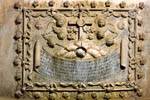|
|
| Modern Greek Stone-Carving |
1844 Monastery of St Paul Marble, 60 x 75 cm Workshop of Zacharias D. Filippotis, Tinos |
|

|
This is the founder's inscription for the katholikon, which was built in 1839-44 by the Tinian empirical architect and marble-carver Zacharias Filippotis, father of the great modern Greek sculptor Demetrios Filippotis. The detailed inscription is written on a scroll with curled edges: TO ΣTEPEΩMA TΩN EΠI ΣOI ΠEΠOIΘOTΩN ΣTEPEΩΣON / KYPIE THN EKKΛHΣIAN HN EKTHΣΩ TΩ TIMIΩ ΣOY AIMATI TH 23 / AΠPIΛΛIΩ 1839 ΣYNΔPOMHΣ ΣΩΦPONIOY APXIMANΔPITOY KEΦA/ΛINEOY ETEΘH ENΘAΔE O ΠPΩTOΣ ΘEMEΘΛOΣ TOY IEPOY TOYTOY / NAOY TH AYTH HMEPA ΣYNEKPOTHΘH IEPOΣ ΣYΛΛ(O)ΓOΣ KAI EΣTEP/EΩΘH O KOINOBIAKOΣ TYΠOΣ EKXEON TO ΣEΛAΣ TΩN ΦAEINOTATΩN / ΣOY MAPMAPYΓΩN KYPIE 1844 AΠPIΛIOY 23 K(AΘ)HΓ(OYMENOY) ΣΩΦPON(I)OY APXIM(ANΔPITOY) KAΛIΓA (Make fast, Lord, the firmament of them that believe in thee, the Church which thou won with thy sacred blood. On 23 April 1839, with the contribution of Archimandrite Sophronios of Kephallonia, was placed here the foundation stone of this sacred church. On the same day was formed a sacred society and the rule of the coenobium was determined. Shed in abundance the radiance of thy brightness, Lord. 1844. April 23. Hegumen Archimandrite Sophronios Kaligas). Above the scroll rises the Lord's cross on Calvary. It is adorned with a floral wreath, and flowers grow from the base, in accordance with hagiological texts, symbolising the 'wood of life', the tree of Paradise. Buried in Calvary we can see Adam's skull, which, according to tradition, was soaked with the blood of Christ, becoming a type of the redemption of the dead of ages. The blood, which is rendered in colour, flows down from the base of the cross and envelops the skull. In the upper part of the composition, the cross is attended by three cherubim on either side, and in the corners are the sun and the moon, which were 'darkened' at the Crucifixion. The whole scene is surrounded by an ornate frame of ribbons and flowers. Though the relief is not signed, we may be certain that it was done by the architect himself. Technical and morphological details, including the rendering of the rocks of Calvary, the wedges bracing the cross, and the facial types, link it with another, signed, work of his, dated 1841, in the Church of the Myrtidiotissa on Kythira (Florakis 1995, pp. 24-6, fig. 3). The deep carving and the balance of the composition prove Zacharias Filippotis to have been no less skilful a marble-carver than he was an empirical architect.
| |
|
Bibliography: Smyrnakis 1903, p. 603 (the inscription). Millet - Pargoire - Petit 1904, p. 145.
| ||
| A.E.F. | ||
| Index of exhibits of Monastery of St. Paul's 19th century |
||
Reference address : https://www.elpenor.org/athos/en/e218bg5.asp